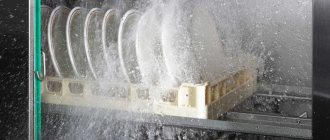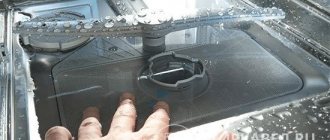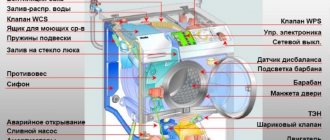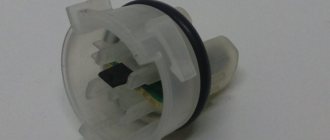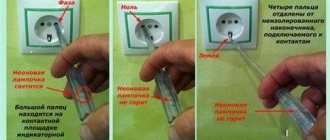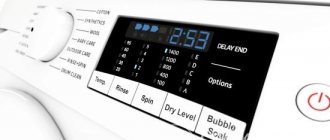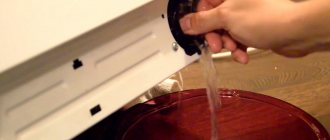You loaded the dishwasher as usual, added detergent, pressed the power button, but the wash cycle never started. The dishwasher doesn't work. What's happened?
To begin with, it’s worth deciding exactly how the dishwasher “doesn’t work.” According to the experience of RemBytTech specialists, users often understand various situations by this concept. The most common of them:
- The machine turns on, draws water, but the sink does not start. In this case, most often we are talking about the failure of the circular pump or heating element. This situation is most fully analyzed in the article “Why the dishwasher does not wash or does not wash dishes well.”
- The dishwasher turns on, the display lights up, but after pressing the “Start” button there is silence. Water does not fill and the wash cycle does not start. This “behavior” is typical when the water supply valve is faulty or the lock is broken. This problem is discussed in more detail in the article “Why the dishwasher does not fill with water.”
- After turning on the dishwasher, the drain pump immediately starts working, but the appliance does not respond to the buttons. This means that the machine has turned on Aquastop, a leakage protection system. It is recommended to drain the water from the pan by pulling out and tilting the machine forward (or simply wait until the moisture dries on its own) and restart. If the problem repeats, you have a leak in the machine itself or the communications connected to it, and it needs to be fixed. Troubles associated with leaks are described in the material “Why does a dishwasher leak.”
Note! When a fault occurs, almost all modern dishwashers beep and indicate a malfunction with an error code, displaying it on the screen or flashing a certain set of indicators (in models without a display). If you see an error code when you turn it on, refer to the operating instructions to decipher it. This will help you understand what kind of problem occurred.
However, in some cases the indication does not light up and the dishwasher does not turn on at all. It is precisely this option, when the equipment does not show any “signs of life,” that we will talk about in this material.
Broken door lock
Symptoms: The power light is on, but the machine does not turn on.
If for some reason the door is open or not fully locked, the dishwasher's electronics will not allow it to turn on. First, just make sure that you don’t forget to close the door: maybe there is no damage. Then check that the dishes do not interfere with the closing of the door. When all the obvious reasons have been exhausted, you can move on to a more detailed study for possible breakdown.
Check to see if the machine door is warped. To adjust the door level, mounting bolts are provided. By the way, misalignment can also be caused by initially uneven installation of the dishwasher. Carefully examine the rubber seal around the perimeter of the door: perhaps it is torn somewhere, worn out, or simply slipped off.
The door lock may break: spring, cable, plastic parts. It is unlikely that the lock will be repaired; it needs to be replaced.
It is possible that the electronic lock may fail: in this case, the dishwasher will not turn on even when the door is closed. It is better to entrust it to a qualified specialist to accurately determine the cause of the malfunction and efficiently eliminate it.
How to repair a dishwasher with your own hands?
If you have decided where to look for a breakdown, then our recommendations will help you deal with it. The first thing to do when an error occurs on the scoreboard is to restart the program. This will help eliminate system failure. The dishwasher control may malfunction after a sudden power outage.
- Unplug the machine;
- Wait 15 minutes;
- Turn on the equipment.
If the code disappears, it may be due to a system failure. Obvious signs of breakdown require immediate repair.
Fill and drain system problems
The main malfunctions of the tracts occur due to blockages. The inlet filter, like the hose, becomes clogged with debris from the water supply. This is small debris, rust, scale. The filter is equipped with a fine mesh that protects the dishwasher system from debris. To clean the tract:
- Close the inlet valve.
- Disconnect the inlet hose from the housing. Water may spill out of it, so have a container or rag ready.
- Behind it is a filter. Remove it with pliers.
- Rinse the parts with warm water; if the mesh is heavily soiled, soak the mesh in a solution of citric acid.
Experts recommend installing a flow filter in front of the hose. It will cleanse the water of salts and make it “softer”.
Behind the filter there is a solenoid valve. When liquid is supplied, it opens the membranes and fills the tank. Voltage drops in the network lead to burnout of the valve coils, as a result of which they stop receiving module commands. If the coils burn out, the entire valve is replaced.
Problems with water supply can be caused by the Aquastop hose. During a leak, its sponge becomes saturated with liquid and blocks the passage. Install a new hose.
The drain path becomes clogged much more often. Poor removal of food residues from the surface of the dishes, infrequent cleaning of the drain leads to blockage, and then to pump malfunction. Damage can be prevented by following simple rules:
- Clean dishes thoroughly before loading.
- Remove dirt from the chamber at least once a week, or better yet, after each wash.
- Use high-quality powders and washing tablets.
How to restore the drain yourself:
- Open the bunker;
- Remove the dish trays;
- Unscrew the filter at the bottom and remove the mesh;
- Clean the parts from debris;
- Liquid accumulates in the mounting hole - remove it with a sponge;
- Remove the protective cover;
- Wear gloves and clear any blockage from the pump impeller. Be careful, fragments of broken dishes can block the operation of the impeller.
Breakdown of other components
In modern dishwashers, electronics control all stages of the washing process, including the serviceability of its elements. If any of them fails, does not respond to diagnostic commands, or reports problems, the machine may be prohibited from starting. The circulation or drainage pump, sensors, relays, electronics, etc. may break down.
It is very difficult to determine exactly what the reason is, and even more so to repair a faulty unit without special equipment. And remember - replacing, for example, a pump motor is a very expensive “pleasure”, so do not allow the machine to constantly leak.
Further repair of Electrolux PMM
But this sensor is a fairly reliable element and rarely fails. Note that after dismantling the bottom cover, what immediately caught my eye was that there were traces of water and grease on all parts. And the Aquastop unit is also doused. This indicates that there is a leak that has caused the microswitch to fail.
On the first cycle, no traces of water were found. But it turned out that the car was not heating up. After checking the heating element, which in this model is flow-through, it turned out that it had burned out. Thus, two devices are already subject to replacement, but it is important to identify the cause of the leak, since it was precisely this that caused the breakdown of the dishwasher.
Flow-through heating element
The second run also did not give anything, but on the third attempt a leak appeared. Water flowed from the pipe, and the stream was directed to the heating element. The reason has been identified, and for proper operation, three parts need to be purchased and replaced:
- AquaStop system microswitch;
- flow heating element;
- damaged pipe.
Heating element with pipe
It is necessary to select in accordance with the serial number, which is located on the sticker on the right side of the door. It is important!
Vehicle code
After inspecting the pipe, a through hole was discovered, which was clearly caused by mechanical damage. It can be assumed that a hard element got inside the system, which damaged the rubber. There is a fine mesh on the inlet hose, so this could not happen through the water supply.
Pipe branch
Water heater
The only option left is through dishes. Apparently a wash cycle was run without filters and something got inside.
Expert opinion
I work in the household appliance repair industry. Extensive experience in restoring washing machines and dishwashers.
Ask a Question
Conclusion: it is imperative to clean dishes from large contaminants and check for the presence of protective nets.
The reasons why the dishwasher does not turn on were considered. This applies to different brands, because the PMM device is similar. The technical execution of certain processes, as well as parts, may differ. Unlike washing machines and dishwashers, there is practically no interchangeability.
Control board failure
Symptoms: any: if the control unit fails, it is impossible to predict its behavior: for example, the dishwasher may turn on and off randomly, the indicators may flash feverishly, and similar madness.
Of course, only a qualified specialist can accurately determine that a faulty control unit is to blame. And an unprepared person should definitely not get into it: the consequences will be fatal, including possible breakdowns of other expensive components of the dishwasher. Usually the control module is changed or reflashed.
What to do if there is no indication in the dishwasher and it does not start
If your dishwasher does not react at all when turned on (even the power indicator does not light up), check first:
- Availability of electricity. Perhaps the outlet is faulty, the dishwasher has been knocked out, or there is no electricity in the entire house.
- The dishwasher's power plug and cord are in good working order. Inspect the dishwasher's power cord and plug. Before unplugging it from the socket, for safety reasons, it is recommended to turn off the electricity in the apartment at the switchboard. If you notice damage, leave the equipment unplugged and call a professional.
If everything is normal with the power supply to the dishwasher, most likely the cause is a breakdown.
PMM does not remove waste water
Sometimes users, approaching the dishwasher, notice that the program has ended long ago, and the water does not leave the chamber. Typically, liquid is not removed from the hopper due to a blockage in the drain system. Pieces of food that remain on the dishes get into the duct and clog the filter.
The first thing to check will be the drain hose. Inspect it, make sure that the sleeve is not pinched or bent. It is advisable to disconnect the pipe from the PMM and rinse it under running water.
Next, check the PMM filter, for this:
- turn off the power to the machine;
- open the loading door;
- take out the dish baskets;
- find the drain filter, it is located at the bottom of the chamber;
- Unscrew the filter element and clean it;
- remove dirt from the seat.
The pump impeller is hidden behind the drain filter. It is recommended to immediately clean it of debris. It is possible that the rotation of the blades is blocked by a foreign object, so the drainage does not occur.
Another possible reason for incorrect drainage is pump failure. Node diagnostics are performed with a multimeter. The pump cannot be repaired; in case of malfunction, the element will have to be replaced.
Poor cleaning of dishes
Recently, one can increasingly come across complaints from dishwasher owners that the equipment cannot fully cope with its work, and it requires repairs, since the dishes at the end are not clean enough, and therefore they need to be washed manually. The reasons for this may be different: the wrong mode was selected, or the water temperature did not meet the norm, or failure of internal parts of the equipment.
In addition, an important point is that if the pressure of the water jets is not strong enough, the remaining food will not be washed away in the time allotted for the dishwasher to operate. Also, the reason may be an insufficient number of jets produced or their speed will be insufficient, which means that the thrust will not be able to force the rocker arms to rotate sufficiently, as a result of which some area of dirty dishes will be uncleaned.
The reasons for the insufficient pressure of some jets may be the following:
- nozzles clogged with debris;
- clogging in the filter area, resulting in not enough water getting into the pump;
- a part such as a pump impeller wears out and does not produce the required pressure;
- wear of one or more bearings or breakdown inside the engine, which leads to a decrease in the number of revolutions.
You can clean the nozzles yourself, and it does not require opening the dishwasher body. It is enough just to remove one or another rocker arm and carefully clean the injectors with a toothpick or needle.
Typical breakdowns and error codes of a Siemens dishwasher
The design and principle of operation of the Siemens PMM is practically no different from other models. But some problems are especially typical for this brand. If an error code appears on the display, look at the instructions. The manufacturer indicates the meaning of the icons. And if you want to find out the details of solving the problem, the article “Fault codes for Siemens dishwashers” will help.
Here are the most common ones:
- E1 - water does not enter the tank.
- E7 - drying does not work.
- E9/E10 - the machine operates without heating.
- E15 - the Aquastop leakage protection has activated.
- E21/E23/E24 - water does not leave the tank, problems with the drain pump.
- E27 - incorrect network voltage.
How can you determine what is broken in the dishwasher if the code does not light up on the display? To do this, pay attention to the external manifestations of the breakdown. What users most often contact the service center with:
- The machine draws water slowly, the program freezes in the middle of the cycle . The reason may be a clogged filler path or a malfunction of the solenoid valve.
- PMM does not wash dishes well . The main problem is blockage. It is also possible that the circulation pump may break down or due to operating errors.
- The drain doesn't work . The problem is a clogged filter and a blocked pump impeller. Pump failure requires replacement.
- The program is not selected, the equipment is turned off . Problem with the electronic module.
Some problems can be solved at home. Follow our instructions below.
Dishwasher capacitor burned out
The second problem that most often occurs is the capacitor problem. The problem occurs quite often, since the quality of electrical energy is often very poor. Voltage surges and network interference can cause the capacitor to break through and stop working. This also leads to the fact that the Bosch, Hansa, Electrolux, Beko machine does not work.
You can only get to the condenser by slightly disassembling the dishwasher. The condenser is located on the circulation pump.
If it is damaged, then you need to buy exactly the same one and replace it. During replacement, you can clean the terminals of the wires that connect to the capacitor and treat them with a water-repellent agent (sold in electrical stores).
How to replace the seal:
- Open the hopper door.
- Tear off the old perimeter seal.
- Insert a new cuff into the groove and spread it.
- The excess can be trimmed off. Make sure that the elastic fits tightly into the groove.
For details of the replacement, watch the video:
After eliminating the causes of the leak, drain the water from the pan and continue operation.
The washer does not start
The reasons are similar to the problem of blocked nozzles . You launched the program, the machine responded, the lights on the panel lit up. But the washing does not start. Why is this happening?
First, reload the dishwasher. There may be a glitch in the system.
How to solve problems with a new dishwasher
Repair activities should not be started without checking the warranty periods for the dishwasher. Most often, the manufacturer provides a 1-year warranty, but responsible companies extend the period of free repair or replacement to 5 years.
If the machine breaks down during the first year of operation, it is not recommended to disassemble or replace spare parts on your own. You should immediately contact the store where you purchased the dishwasher and clarify the repair rules.
When purchasing a PMM, you should also inquire about the warranty period. If they are not indicated in the product card, then the sales consultant should provide complete information
Approximate procedure:
- submitting an application for warranty repair - the store or service center must provide a special form or fill it out yourself;
- choosing a convenient time to remove equipment;
- drawing up a transfer act at the time of export;
- if desired, submit an application for the issuance of replacement goods.
The last point is spelled out in the law “On the Protection of Consumer Rights” (Article 20). The application is handed over to the store representatives against signature, the original is kept by the buyer. Instead of broken equipment, they issue a new one of the same class for the entire repair period.
If the device weighs 5 kg or more, the store takes care of its delivery to the service center. Dishwashers belong to the category of equipment with free transportation
But you shouldn’t always rush to hand over your equipment for repair. To ensure that seemingly correct actions do not turn out to be an incident, you should first check whether the machine is connected correctly. So, the dishwasher may not work because you forgot to plug the plug into the socket or open the water supply tap.
If you installed and connected the dishwasher yourself, it would be a good idea to check whether everything was connected correctly. We presented the main nuances of self-connection in the following article.
It is necessary to check whether the wiring is working properly and whether the circuit breaker in the apartment electrical panel is turned on. You can check the current supply to the outlet using another electrical appliance.
If all connection steps have been completed correctly, but the new machine does not perform the task or works intermittently, we recommend using warranty service.
Watch a video on cleaning equipment:
Couldn't fix your machine by cleaning? Then diagnose the pump. The node is located at the bottom of the body. If there is a problem, just disconnect the wiring of the part, turn it and remove it from its place. After this, a new node is installed.
Heating fault
The first sign of heating problems is poor dishwashing. Fat does not dissolve in cold water, so you will remove wet but dirty utensils from the chamber. Diagnostics will help to accurately determine the cause of the problem. You need to check:
- A heating element;
- Temperature sensor;
- Their wiring and control triacs on the board.
Replacing the heating element in Electrolux PMM models is complicated by the presence of a non-separable heating block. Buying a replacement part will cost 3000-4000 rubles. Think about whether the game is worth the candle. If the equipment is already old, it makes sense to add money to a new dishwasher rather than buy a unit.
Have you decided to make a replacement? Then here is the sequence of steps for disassembling the PMM:
- Unplug the machine;
- Shut off the water supply and disconnect communications;
- Remove the baskets from the hopper;
- Remove the filter and water at the bottom;
- Unscrew the five screws securing the heater;
- Turn the body on its side;
- Remove the bottom;
- The block is connected to a circulation pump;
- Turn off the wiring, release the clamps;
- Rotate the block and disconnect it from the pump;
- Install the new unit in reverse order.
To avoid problems with network outages, connect a voltage stabilizer.
The machine does not wash dishes well
Problems with washing are possible when:
- poor supply of detergents;
- overloading the machine with dishes;
- blocking the sprayer;
- circulation pump malfunction.
Check the powder supply simply. Open the cuvette - if the remains of the tablet are visible in it, it means that water is not entering the compartment well. Check the placement of dishes in the hopper. Maybe a large plate is blocking the compartment, or the supply hose is clogged. Clean the cuvette after each wash to prevent detergent from accumulating in it.
Overload interferes with fluid circulation. When one device overlaps another, water does not wash the surface. There must be a gap between the plates for high-quality washing.
The rotation of the rocker arm, again, can be blocked by the plate. There may be a blockage or foreign object in the way. Clean the sprayer holes - nozzles.
After this, the pump is inspected. If it breaks and does not pass liquid, the unit needs to be replaced. The case will need to be disassembled. Remove the bottom, disconnect the pipes leading to the pump. An example of the repair is shown in the video:
Leak in the system
Damage or corrosion of the unit body leads to leakage. Although this is rare, it is not recommended to do any soldering yourself. Such repairs will not last long, so you will have to completely replace the body.
When Aquastop is activated, water may end up in the sump or leak from the hose connections. Inspect the following items:
- Hose fastenings. Tighten the clamps tighter.
- Pump gasket. If worn, install a new element.
- Door seal. Loss of tightness leads to leakage. Open the door, remove the old seal and install the new one.
Check to see if the pallet is damaged. Then it’s better to put a whole stand. If the float sensor malfunctions, a working part is installed.
